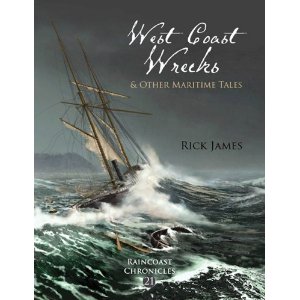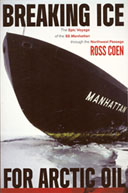Book Reviews

Raincoast Chronicles 21
West Coast Wrecks and Other Maritime Tales
by Rick James
This is a great book in the West Coast series, about the ships of B.C. coast including the mysterious sinking of the GEORGE S. WRIGHT of the famed Alaska Overland Telegraphic Expedition of 1860s. Get it here.

Breaking Ice for Arctic Oil:
the Epic Voyage of the SS MANHATTAN Through the Northwest Passage
written by James Coen
reviewed by J.P. Goforth
Ask any Alaskan if they have heard of the MANHATTAN and you are likely to get a blank stare. Ok, it was over 40 years ago but still, the voyage of the leviathan oil tanker MANHATTAN through the Northwest Passage in 1969 launched the American rush to Arctic resources.
As the biography of an extraordinary vessel, the story is riveting enough: massive ship built as a fluke gains worldwide attention and becomes famous. Plus Coen places her at the nexus of global oil industry competitiveness and then weaves in the ages-old question of who has the right of passage over the seas. Even before her bow crushed a single massive iceberg, in a manner befitting her size she spun the compass on conventional ways of thinking about the technology of moving millions of barrels of crude oil while accommodating nascent ideas of environmental protection. On the political intrigue front, Coen shows how the course of her trip through the waters of the Canadian Archipelago challenged the world's notions of the sovereignty of the fabled Northwest Passage itself. These issues are all still with us.
The discovery of oil in Prudhoe Bay two years earlier cranked up the engines of the oil industry as they puzzled out how to get millions of barrels of crude oil from the frozen north to thirsty world markets. In a completely breathtaking move, Humble Oil & Refining Co. grabbed the helm launching the Arctic Tanker Test. Their intent was to test a model of safely and profitably shipping oil through the ice fields, a feat no other industry rival had attempted. They boldly reforged an obscure giant cargo ship into a mammoth ice-breaking oil tanker. Coen explains this marvel of modern science with exacting detail describing hull sensors, TV cameras and a wealth of technological break-throughs.
The elements that made the MANHATTAN a cumbersome expensive cargo ship when she was built in 1962-like her then-innovative double hulled steel construction, twin screw propulsion, and gas guzzling high horsepower-made her the ideal candidate for an Arctic cruise. With a few modifications. He describes how the ship was actually dismantled into several football field-sized pieces which were hauled to shipyards up and down the East Coast, reinforced and renovated, towed back to the main yard in New Jersey, and reassembled. Over $50 million dollars later, she boasted highly technical scientific and photographic laboratories for a raft of scientists who would collect data, bolstered rudder protectors and collision chocks, state of the art communications and navigation systems, and a heliport on the stern. And somewhat cramped quarters for over 100 crew and scientists, observers, and journalists. At just over a thousand feet long-in downtown Anchorage she would stretch along 4th Avenue from A Street to E street--with displacement tonnage of over 150,000. Amid great fanfare in late August of 1969, the ship headed north by northwest on her historic journey.
Coen takes us into Canadian waters with all the drama of failed diplomacy and nationalistic hubris as the seafaring nations of the planet observed the struggle for the right of passage play out. Neither Humble Oil nor the U.S. State Department requested Canadian permission for the journey, fearing to confirm that country's ownership of the waters. Although no one ever really expected, back then anyway, that a regular trade route through the Northwest Passage would become reality, issues of safety, rescue, and potential pollution, churned up the questionable ability of Canada to lay exclusive claim to the waterway. Coen expertly uses the story of the Canadian Coast Guard escort by the JOHN A. McDONALD to present all the maritime boundary claims, treaties, proclamations and declarations involved in the contentious sovereignty issue.
The theme of environmental concerns over ocean pollution runs in a deeper current throughout the narrative. Although the U.S. passed domestic legislation regarding pollution in 1899, he explains, transoceanic shipment of crude oil, diesel oil, and other lubricating oils had become an international issue. Underscored by the 30 million gallon oil spill of the TORREY CANYON in 1967, the world closely watched the transit of the MANHATTAN.
Well illustrated with graphics and photographs the 215 page book is a page turner. The forward by former director of the U.S. Arctic Research Commission Lawson Brigham-arguably the most knowledgeable Alaskan Arctic expert-puts the politics of oil in perspective. Based on comprehensive accounts from U.S. and Canadian government documents, oil company records, and media coverage of the voyage, Coen gives a densely noted and very readable account of the tensions and triumphs of the historic voyage. Ten pages of bibliography and a very good index puts this book on the must have reference shelf.
The story of how the MANHATTAN came to break the Arctic ice and the oil company that staked so much on its success is a valuable cautionary tale for current times as the oil industry continues the quest for the same risky riches.
Available for Kindle here.
|



